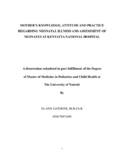| dc.contributor.author | Gathoni, Ann | |
| dc.date.accessioned | 2016-05-03T07:52:34Z | |
| dc.date.available | 2016-05-03T07:52:34Z | |
| dc.date.issued | 2014 | |
| dc.identifier.uri | http://hdl.handle.net/11295/95416 | |
| dc.description.abstract | Introduction: Neonatal mortality in Kenya remains high accounting for 42% of under 5
mortality. Neonatal infections account for 36% of these deaths. With two years to 2015, the
millennium development goal four may not be achieved unless accelerated measures are put in
place to reverse the trends. Early recognition of signs of illness in a neonate will lead to early
seeking of care and avoid overt outcomes associated with late presentation and severe disease.
Objective: To determine the knowledge , attitude and practices towards recognition of danger
signs of neonatal illness, among mothers delivering at Kenyatta National Hospital. A second
objective was to determine the prevalence of ill health among the apparently well newborns in
the maternity wards.
Study design: Descriptive cross sectional hospital based survey.
Study population and setting: Mothers and their babies in Kenyatta National Hospital’s post
natal wards.
Research methods: Qualitative and quantitative methods were used. For quantitative data a
structured questionnaire was administered to the mothers and demographic, social and ante natal
history was obtained. Qualitative data was obtained using focused group discussions. Six focus
groups consisting of eight mothers each were conducted. They were interviewed on which signs
of neonatal illness that they knew, which ones were regarded as severe, and immediate measures
that would be taken for sick neonates. Information on cultural practices regarding care of sick
neonates was also sought. Subsequently, the data was analysed. Summary tables were
constructed for grouped data while means and medians were determined for continuous
variables. Appropriate statistical computation was done using SPSS.
Results
A total of 384 mothers were interviewed and their babies assessed. The mean age of the mothers
interviewed was 26.3 years of whom 89 % had post primary education, 72.7% were multipara
and 64% had attended antenatal clinic for four or more times. Overall 97.7 % of the mothers
knew at least one danger sign. There was poor knowledge of convulsions and difficulty in
breathing as newborn danger signs. Older mothers, multipara and those who had tertiary
education were likely to know more than one danger sign. Overall 7.9% of neonates in the post
natal wards were found to be unwell | en_US |
| dc.language.iso | en | en_US |
| dc.publisher | University of Nairobi | en_US |
| dc.rights | Attribution-NonCommercial-NoDerivs 3.0 United States | * |
| dc.rights.uri | http://creativecommons.org/licenses/by-nc-nd/3.0/us/ | * |
| dc.title | Mother’S Knowledge, Attitude And Practice Regarding Neonatal Illness And Assessment Of | en_US |
| dc.type | Thesis | en_US |
| dc.description.department | a
Department of Psychiatry, University of Nairobi, ; bDepartment of Mental Health, School of Medicine,
Moi University, Eldoret, Kenya | |



